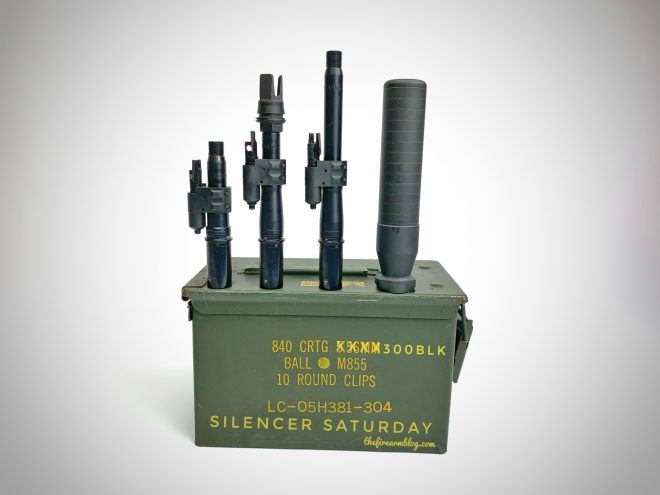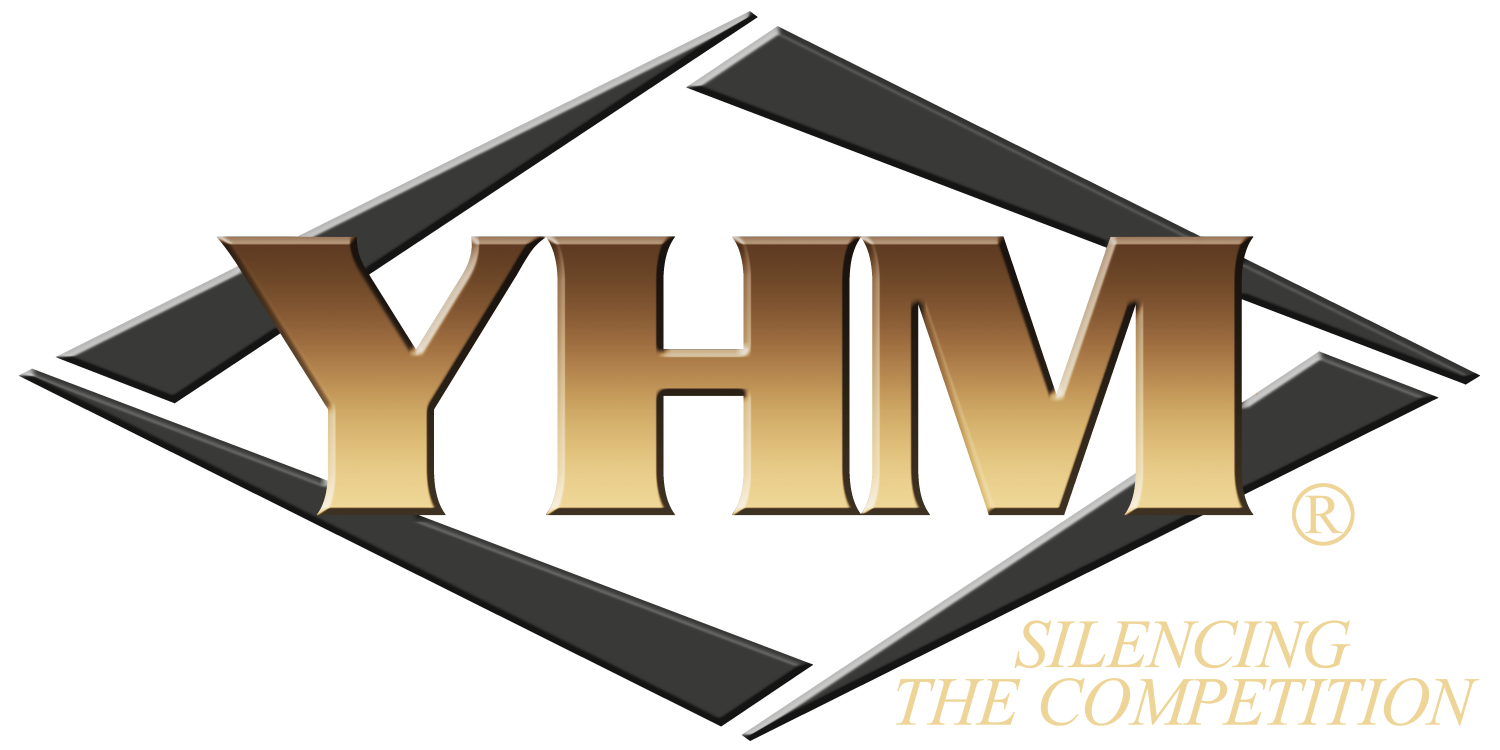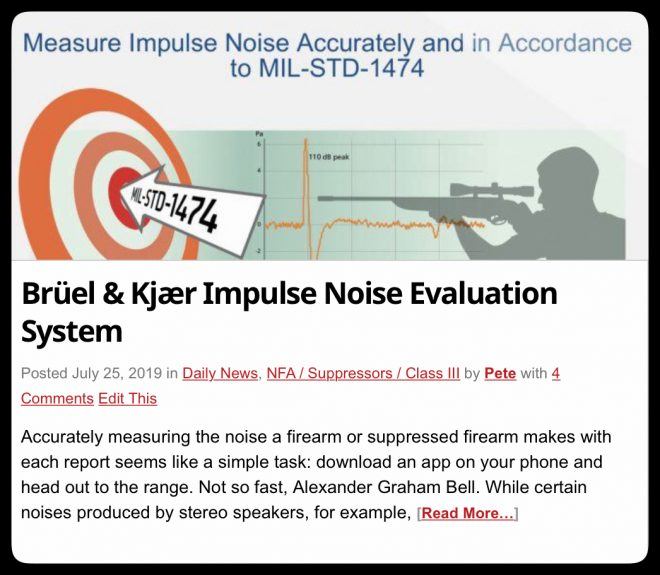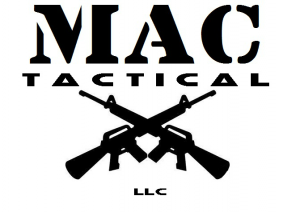Good morning everyone and thanks for joining us for another installment of TFB’s Silencer Saturday. Last week we discussed a controversial topic – legally converting solvent trap kits into registered silencers. Your responses, both public and private, ran the gamut, with some of you arguing that solvent traps are a disaster waiting to happen. The other side of the story is that Form 1 silencer builds are an inexpensive, fast and satisfying way to tame your firearms. My arguments surrounding any gun law or regulation will always favor individual liberties. However from some of the comments on our Facebook page and statements made by the media after the attacks last week, I thought we should touch on some suppressor basics for beginners searching for actual facts.
Above: MCX Barrels – 5.5” Rattler; 6.75” PDW; 9” – SIG Sauer SRD762Ti-QD
SILENCER SATURDAY #85: Top 7 Suppressor Basics For Beginners
While we could write a book on silencer ownership in America, and probably should, I picked what I thought were the top seven suppressor basics for beginners. Even if you aren’t in the market for a silencer, knowing some facts will help you end up on the high side of any potential debate.
1. Silencer Versus Suppressor
Hiram Percy Maxim invented the firearm silencer in 1902 and patented his design and trademarked his Maxim Silencer In 1909. With the creation of the National Firearms Act of 1934, the U.S. government regulated silencers by law. While it is common knowledge that silencers do not actually silence a firearm, their legal name on all government paperwork and laws and regulations is in fact Silencer. The term suppressor is interchangeable when used in unofficial discussions, but for correctness, silencer should be used on official forms and documentation.

Suppressor Basics – Maxim Silencer – credit: Tornado Technologies

Suppressor Basics – Maxim Silencer – credit: Tornado Technologies
2. How Quiet Are Silencers?
While the pressure waves of a discharged firearm can be measured with expensive scientific equipment, the perceived noise reduction of a suppressed firearm is largely subjective. Everyone’s hearing is different, and the host weapon, ammunition and the silencer itself all play a role in how loud a suppressed shot actually sounds. In addition, the speed at which the bullet is traveling will play a part in suppressing a gun since even bullets produce a supersonic crack when breaking the sound barrier. In general, here are the top suppressed rounds ranked in terms of overall suppression:
- Subsonic Rimfire
- Supersonic Rimfire
- Subsonic Pistol
- Subsonic Rifle
- Supersonic Pistol
- Supersonic Rifle
In terms of actual noise reduction, the American Suppressor Association put together an excellent chart with noise comparions for various commercial and residential items..
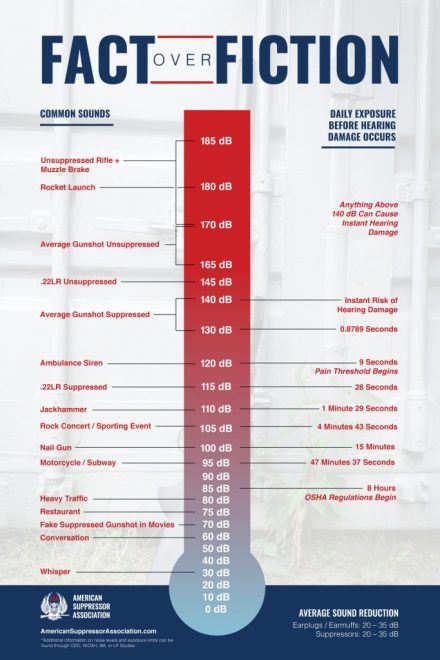
Credit: American Suppressor Association
3. Are Silencers Legal?
Yes, at the federal level, silencers are legal. Unfortunately, several states have their own laws preempting civilian ownership, so it really depends on your residency. Currently 42 states allow silencer ownership.
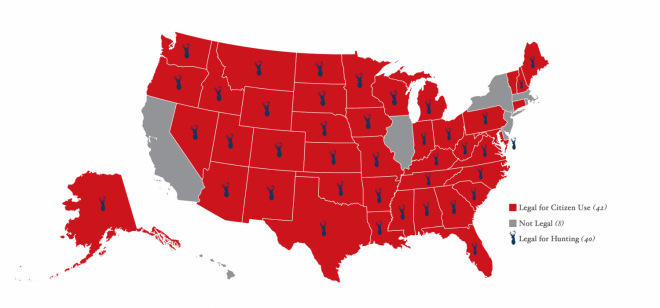
Credit: American Suppressor Association
There are other restrictions as well (ASA):
- Be at least 21 years of age to purchase a suppressor from a dealer.
- Be at least 18 years of age to purchase a suppressor from an individual on a Form 4 to Form 4 transfer (contingent on state laws).
- Be at least 18 years of age to possess a suppressor as a beneficiary of a trust or as a member of a corporation (contingent on state laws).
- Be a resident of the United States.
- Be legally eligible to purchase a firearm.
- Pass a BATFE background check with a typical process time of 8 to 10 months.
- Pay a one time $200 Transfer Tax.
- Reside in one of the 42 states that currently allows civilian ownership of suppressors.
4. How Are Silencers Purchased (Transferred)?
The majority of silencers are purchased through a licensed federal firearms dealer, much like someone buying a pistol or a rifle. After deciding on a make and model, the buyer pays the dealer for the silencer and then fills out the transfer paperwork known as an ATF Form 4. The this form includes information about the silencer, the transferee’s biographical information and a short list of criminal history questions.
After completing the Form 4, the transferee includes two passport photos, two fingerprint cards and a tax payment of $200 for each silencer being transferred. The whole package is then sent to the ATF for processing where the applicant can wait for up to 12 months for approval. A copy of this paperwork is also sent to the applicant’s Chief Law Enforcement Officer (CLEO) as a notification of the transfer. Once the approval is received by the FFL (transferring dealer) , the applicant can pick up his or her new silencer.
Individual transfers outside of a licensed dealer are permitted as long as the ATF Form 4 approval process noted above is followed before the buyer/transferee takes possession of the silencer.
5. How Much Do Silencers Cost?
Much like cars, there are a range of features and styles that can determine a silencer’s cost. For a basic, direct thread rimfire suppressor, a buyer can expect to pay between $200-$300. Whereas rifle silencers built to withstand heavy fire, with mounting systems and unique materials can cost more than $1500. The average street cost of a typical centerfire silencer is about $600-$700.
6. Are Their Any Ownership Restrictions For Silencers?
Unlike standard firearms, silencers can not be loaned or left in the possession of someone who is not the actual registered owner as shown on the Form 4 paperwork. So while you may lend out a shotgun to a friend for a day at a trap and skeet club, silencers must remain under the registered individual’s (or entity’s) control. Although secure storage isn’t specifically outlined in the regulations, silencers should be stored in a way that sufficiently restricts access only to those who are the registered owner(s). And, no, the ATF cannot perform warrantless inspections of your NFA items, like silencers, without your permission.
7. Do You Have To Carry Your Silencer Paperwork With You?
There is no requirement to carry around your tax stamp paperwork while you have your suppressor with you. However, since it is the only real proof that you are the actual owner of a particular silencer, making a copy or scan of your approved Form 4 may avoid lengthy discussions at ranges, clubs and the unlikely law enforcement run in. As with everything in life, being polite and professional will get you a long way when interacting with law enforcement about NFA items. Who knows, you may be able to impart some suppressor basics to a cop who will use that knowledge in his next silencer experience – hopefully when they are buying their first silencer.
Well, that’s a good start with some suppressor basics for beginners. I’ve read and seen some truly awful information over the past week and maybe this list will help to educate the uninitiated. Be safe, have fun and we’ll see you next weekend for TFB’s Silencer Saturday.
Silencer Saturday is Sponsored by Yankee Hill Machine:
Buy YHM silencers and accessories at:
Silencer Shop – Hansohn BrOthers – dead eye gun supply –
Mac tactical
All YHM Products At Brownells
DEALERS: If you want your link to buy YHM suppressors included in future Silencer Saturday posts, email: silencers@thefirearmblog.com
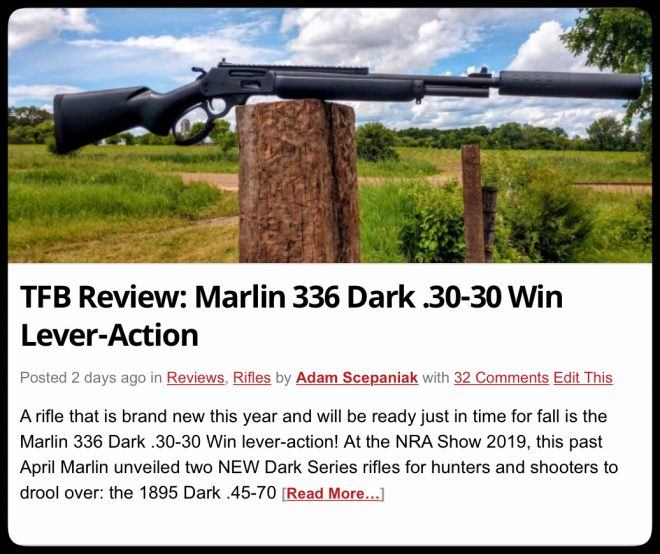
Published on Aug 8, 2019 – TFBTV
In this episode of TFBTV, James Reeves discusses and ranks the three best-selling 9mm silencers from Silencer Shop, and gives you the reasons behind his rankings. Check out today’s video to see if your can made the list.
Read more at: : https://www.thefirearmblog.com/blog/2…
««« PATREON GIVEAWAYS »»»
PLEASE check out our Patreon page if you enjoy our program, and consider helping us at TFBTV out! We give away hundreds of dollars of gear a month on our Patreon page!
https://www.patreon.com/tfbtv
 Your Privacy Choices
Your Privacy Choices
